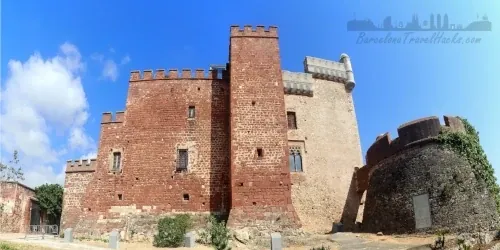Please sign in with Google to view the map.
Sign in with GoogleGava Variscite mine - Parc Arqueològic Mines de Gavà
Variscite is a mineral used to make jewellery and was thought to originate outside of Europe until a 6,000 year old neolithic mine was discovered in Gavà
About Parc Arqueològic Mines de Gavà
The Mines of Gavà, Parc Arqueològic Mines de Gavà are 6,000 years old and some of the oldest mines known. The complexity of their structures, and the fact that they are the only ones of Varicite, an ornamental mineral used for necklaces across different Neolithic sites in Western Europe.
Gavà was trading in Varicite. Blades of Flint from Provence (France) and axes made from Obsidian stone from Monte Arci (Sardinia, Italy) have been found on the site. Biological material such as polen has been recovered form the site which has given a great deal of insight into life 6.000 years ago in this area.
Of the archaeological finds, the Venus of Gavà is a ceramic figure found incomplete and broken between the filling of one of the mining wells. It is black, with embossed and incised motifs that reproduce, among other features, the sun-shaped eyes, the nose, breasts, arms adorned with bracelets, and hands resting on a prominent belly, such as that of a pregnant woman. The femininity of the piece, motherhood and black color, a symbol of fertility, indicates the belief in fertility gods at the time.
Once the Varicite seams wer removed, the tunnels were reused as burial chambers, with skeletal remains being found burried with several high value objects such as flint arrows, pots and jewellery. The chambers were seled with a stone plug. No one know why but it was perhaps to stop the dead from returning to walk among the living. The skeletal remains of women, men and children indicate an avarage adult life expectancy of 30 years in the mine.
Variscite and Green Turquoise Mineral
Variscite is a hydrated aluminium phosphate mineral. It is a relatively rare phosphate mineral and is sometimes confused with turquoise. However, variscite is usually greener in color from the presence of small amounts of trivalent chromium.
Variscite has been used in Europe to make personal ornaments, especially beads, since Neolithic times. Its use continued during the Bronze Age and in Roman times, although it was not until the 19th century that it was determined that all the variscite used in Europe came from three sites in Spain, Gavà (Barcelona), Palazuelo de las Cuevas (Zamora), and Encinasola (Huelva).
- 6,000 years ago, a group of villagers were digging up the land to create a 200 hectare mine lattice to extract a mysterious green mineral, the variscite, used to make jewelry.
- The mine was discovered in 1978 when a construction excavator (urbanise and build the neighborhood of Can Tinterer) broke the surface to reveal the latice structure of mine tunnels.
- Once the importance of the mine was known the current structure was built over the site to clear the tunnels and study the archaeology.
Parc Arqueològic Mines de Gavà History
Image Gallery For Parc Arqueològic Mines de Gavà
Click on any of the 58 images to open full screen gallery player. Note that viewing images is subject to our Fair Use Policy.
Visiting Parc Arqueològic Mines de Gavà
The mine is an active archaeological site and still being investigated by scholars. The real mine has tunnels that are about 1 metre in diameter and follow seams of Variscite. It is not possible to visit the real mine for preservation and safety reasons. However the main mine entrance can be viewed from above.
The Parc Arqueològic Mines de Gavà visit includes a section of reporoduction mine with the tunnels enlarged to stand up in. There are audio visual dispays in the mine which explain what has beene found so far.
- Monday: 10:00h - 14:30h
- Tuesday to Friday: 10:00h - 14:30h
- Saturday: 10:00h - 18:45h
- Sunday: 10:00h - 14:30h
- Monday: Closed
- Tuesday to Friday: 10:00h - 18:45h
- Saturday: 10:00h - 18:45h
- Sunday: 10:00h - 14:30h
- Closed: Non-reading Monday's, public holidays, 1st & 6th january, 24th June, 25th & 26th December, Afernoons of 5th May, 23rd June, 24th December and 31st December.
Parc Arqueològic Mines de Gavà Opening Hours
- Winter: 16th September to 15th June
- Summer: 16th June to 15th September
What to take with you for Parc Arqueològic Mines de Gavà
Access to the archaeological site is via ramps or steps. The replica mine has a lift and so is adapted for people with reduced mobility.
There are no bicycle anchorage points near Parc Arqueològic Mines de Gavà.
Large rucksacks and bags will have to be left in reception to visit the interior of the archaeological site. I was allowed inside with my small 10L museum rucksack.
Parc Arqueològic Mines de Gavà Summary of Prices
Getting to Parc Arqueològic Mines de Gavà
Address: Carrer de Jaume I 7, Gavà, 8850
To get to Gavà use the Renfe RODALIES service catching a R2 or R2 Sud train From Barcelona-Estacio de França, Barcelona-passeig de Grácia or Barcelona-Sants.
Because it is Zone 1, use 1 trip from the T-casual Zone 1 travel Card or the Hola-Barcelona.
The Gavà Mines can be found 15 minutes walking from the train station.
